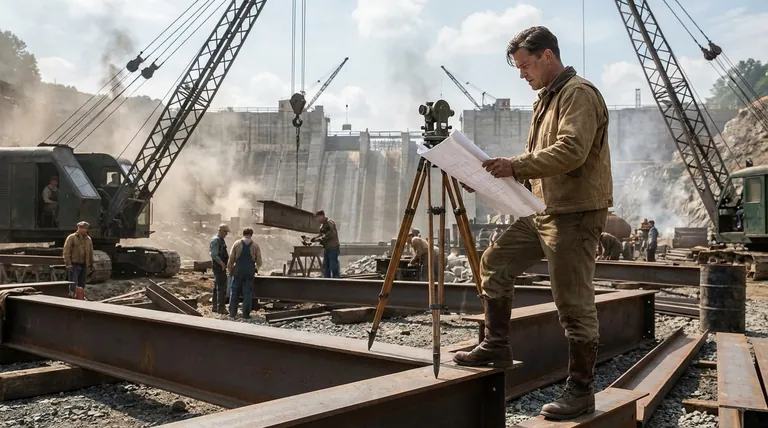The most persistent myth about engineer boots is that they were designed for the operators of steam locomotives. In reality, the name was a clever marketing strategy from the 1940s, aimed not at train workers but at a broader class of skilled professionals, from surveyors to project managers.
The term "engineer" on these iconic boots was never about railroads; it was a marketing label designed to appeal to the aspirational, skilled American worker of the era, linking the product to a title of respect and authority.

Deconstructing the "Train Engineer" Myth
The story of boots designed to protect a train engineer from hot coals and sparks is a powerful image, but it doesn't align with the historical record.
A Matter of Timing
The primary flaw in this myth is a simple one of timing. By the time engineer boots became a distinct and popular style, steam locomotives were already becoming obsolete, being replaced by diesel-electric engines.
The Misleading Function
While the boot's tall, laceless shaft certainly offers protection, its design was for general-purpose durability. The "spark protection" narrative is a romantic story retrofitted onto the boot's features long after its creation.
The True Meaning of "Engineer" in Context
To understand the boot's name, we have to understand what the word "engineer" signified to the American public in the 1940s.
A Title of Skill and Authority
In that era, "engineer" was a broad term often used for any highly skilled technician, surveyor, or on-site project manager. It denoted a professional class of worker with specialized knowledge and management responsibilities.
Evidence from Advertisements
Contemporary advertisements for these boots support this broader definition. They were marketed toward men in roles that required both rugged fieldwork and professional oversight, not exclusively to railway operators.
Why This Myth Endures
Like any good story, the train engineer myth persists because it is simple, compelling, and seems plausible on the surface.
The Power of a Romantic Narrative
The image of a rugged worker wrestling with a massive steam engine is a powerful piece of American folklore. This story is far more romantic and memorable than the reality of a mid-century marketing trend.
The Logic "Feels" Right
The boot’s features—a tall shaft, sturdy buckles, and heavy-duty construction—appear to be a perfect solution for the imagined dangers of a locomotive cab. This apparent alignment between form and a fictional function makes the myth easy to believe.
How to Appreciate the Authentic Heritage
Understanding the boot's true origin allows for a deeper appreciation of its place in workwear history.
- If your primary focus is historical accuracy: Remember the boot as a symbol of the broad, skilled American workforce during a period of massive industrial growth.
- If your primary focus is design: Appreciate its form as a masterclass in creating a durable, protective, and easy-to-wear boot for general hard labor.
- If your primary focus is cultural significance: View the "engineer" name as a fascinating example of aspirational marketing, selling not just a product but an identity.
Knowing the real story replaces a simple myth with a more nuanced history of American industry, marketing, and the identity of the skilled worker.
Summary Table:
| Misconception | Reality |
|---|---|
| Designed for steam locomotive operators | A 1940s marketing term for skilled professionals |
| Features for spark protection | General-purpose durability for rugged work |
| Name from railroad use | Name from aspirational 'engineer' title of authority |
As a large-scale manufacturer, 3515 produces a comprehensive range of durable footwear for distributors, brand owners, and bulk clients. Whether you need heritage-inspired work boots or modern styles, our production capabilities cover all types of shoes and boots. Let us help you build a product line with authentic appeal and commercial strength. Contact our team today to discuss your manufacturing needs.
Visual Guide

Related Products
- Wholesale Anti-Smash & Puncture-Proof Safety Shoes Custom Manufacturing for Brands
- Wholesale Safety Footwear Manufacturer for Bulk & Custom OEM Orders
- Premium High-Cut Waterproof Safety Boots Manufacturing & Wholesale Solutions
- High Performance Fire-Retardant Waterproof Safety Boots
- Custom Wholesale Leather Safety Boots Direct Factory Manufacturing
People Also Ask
- What are the differences between steel toe, composite toe, and alloy toe Wellington boots? Choose the Right Safety Toe for Your Job
- How do safety shoes contribute to cost savings for companies? A Strategic Investment in Risk and Cost Management
- Is it normal to wear shoes in the house? A Guide to Hygiene, Comfort & Culture
- Is there a downside to steel toe boots? Weighing Protection Against Daily Comfort
- What cultural and environmental considerations are tied to wearing shoes indoors? Balance Hygiene, Tradition, and Foot Health



















